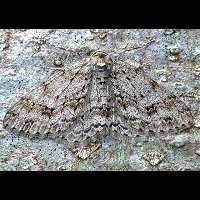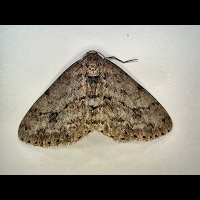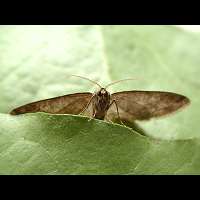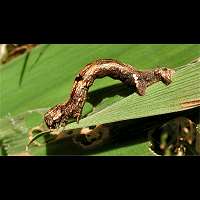Engrailed Moth / Small Engrailed
(Ectropis crepuscularia and Ectropis bistortata)
This is not an easy species to identify. The markings on the wings, though numerous, are arranged in such a way, little grip for the eyes is offered. You can see that in some of our pictures: whatever the background, the animal is not that easy to see. The Engrailed is almost identical to the Ringed Carpet, especially in worn out animals, hardly marked specimens and females. Usually there is a little ring, or a dot surrounded by a ring on the hind wing of the Ringed Carpet, but that may be invisible at times. The Engrailed however often has a " mark in middle of the forewing where a vein splits into two. Alas this may be absent at times. To complicate matters more the Engrailed has lots of melanistic forms. In these lots of markings are invisible, making it hard to identify them. The animals of the second generation (seen from July) are usually smaller and less clearly marked than those of the first. The wingspan is highly variable and may be anything from 36 to 47 mm.
The Engrailed Moth is double-brooded in most of England and Wales, single-brooded in Scotland and further north. In the south of England an occasional third generation may appear. The caterpillars grow fast. They are reddish brown and have a clear black V-shaped marking on the back, behind the head at about 1/5th of the body. The larvae pupate underground and it is the pupa that overwinters. They'll eat anything: shrubs and trees. In the USA they are even found on firs. The Americans call the caterpillar the Saddleback Looper.
Because it appears in two and sometimes even three generations it is seen from mid-March to November. In Northern Britain only one generation develops and there it is on the wing from early April to the end of June only. By day often seen resting on walls, fences, tree trunks etc. Doesn't usually fly till well after sunset, but comes to light, sometimes even in great numbers. Species prefers light forests, gardens, parks and dunes. Very common all over Britain and elsewhere in Europe. Also a common species in Northern America, especially in the east.
In the past this species was treated as two separate species: The Engrailed (Ectropis crepuscularia) and the Small Engrailed (Ectropis bistortata). Recent scientific research has shown however there is only one species. In Britain the situation remains unclear as there might be a third species on the wing there. This however is not very likely. For now you are very safe caling the Engrailed and the Small Engrailed one and the same species: Ectropis crepuscularia.
(Ectropis crepuscularia and Ectropis bistortata)
This is not an easy species to identify. The markings on the wings, though numerous, are arranged in such a way, little grip for the eyes is offered. You can see that in some of our pictures: whatever the background, the animal is not that easy to see. The Engrailed is almost identical to the Ringed Carpet, especially in worn out animals, hardly marked specimens and females. Usually there is a little ring, or a dot surrounded by a ring on the hind wing of the Ringed Carpet, but that may be invisible at times. The Engrailed however often has a " mark in middle of the forewing where a vein splits into two. Alas this may be absent at times. To complicate matters more the Engrailed has lots of melanistic forms. In these lots of markings are invisible, making it hard to identify them. The animals of the second generation (seen from July) are usually smaller and less clearly marked than those of the first. The wingspan is highly variable and may be anything from 36 to 47 mm.
The Engrailed Moth is double-brooded in most of England and Wales, single-brooded in Scotland and further north. In the south of England an occasional third generation may appear. The caterpillars grow fast. They are reddish brown and have a clear black V-shaped marking on the back, behind the head at about 1/5th of the body. The larvae pupate underground and it is the pupa that overwinters. They'll eat anything: shrubs and trees. In the USA they are even found on firs. The Americans call the caterpillar the Saddleback Looper.
Because it appears in two and sometimes even three generations it is seen from mid-March to November. In Northern Britain only one generation develops and there it is on the wing from early April to the end of June only. By day often seen resting on walls, fences, tree trunks etc. Doesn't usually fly till well after sunset, but comes to light, sometimes even in great numbers. Species prefers light forests, gardens, parks and dunes. Very common all over Britain and elsewhere in Europe. Also a common species in Northern America, especially in the east.
In the past this species was treated as two separate species: The Engrailed (Ectropis crepuscularia) and the Small Engrailed (Ectropis bistortata). Recent scientific research has shown however there is only one species. In Britain the situation remains unclear as there might be a third species on the wing there. This however is not very likely. For now you are very safe caling the Engrailed and the Small Engrailed one and the same species: Ectropis crepuscularia.










